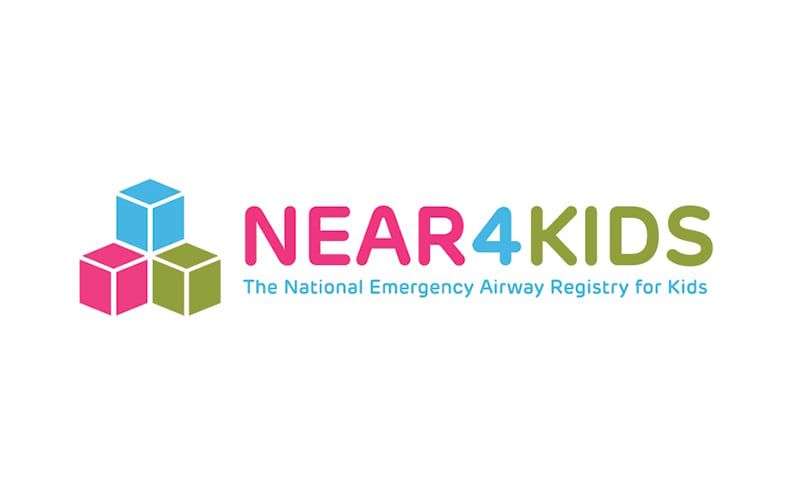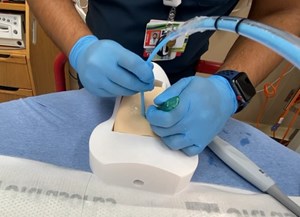
NEAR4KIDS: Defining Tracheal Intubation Safety in Pediatric Critical Care
Emergent tracheal intubation can be lifesaving for critically ill children but is not without significant risks. To chronical the incidence of adverse tracheal intubation associated events (TIAEs) aiming to improve invasive airway management in children, medical professionals from the Children’s Hospital of Philadelphia developed the National Emergency Airway Registry for Children (NEAR4KIDS). This prospective airway registry collects data on all pediatric intubations that occur in participating pediatric intensive care units (PICUs). It began in 2010 with 15 participating PICUs in North America and now includes more than 40 hospitals worldwide.
This group first defined TIAEs as unwanted events which occur as a result of the intubation process (ie, from medication induction to 20 minutes after securing the airway). Non-severe TIAEs include mainstem bronchial intubation, esophageal intubation with immediate recognition, dysrhythmia, emesis without aspiration, hypertension requiring an intervention, agitation, epistaxis, lip trauma or medication errors. Severe TIAEs include cardiac arrest, esophageal intubation with delayed recognition, emesis with aspiration, hypotension requiring more than a 20 mL/kg bolus, laryngospasm, malignant hyperthermia, pneumothorax or pneumomediastinum, direct airway injury or dental trauma. Analysis of these first 15 centers showed that any type of TIAE occurred in 20% of tracheal intubations, with 6% of these identified as severe.1 As with most voluntary databases, considerable variations were noted between PICUs, with site variability ranging from 0% to 44% for any TIAE and 0% to 20% for severe TIAEs, and larger PICUs (>26 beds) were associated with fewer TIAEs. However, after adjusting for patient and provider factors, neither PICU size nor having a fellowship program were associated with fewer TIAEs.2
In addition to collecting data on TIAEs, the providers who perform laryngoscopy are also documented in the database. As pediatric medicine becomes more and more specialized, fellowships continue to grow with fewer procedures available to non-fellow trainees. Not surprisingly, pediatric resident success rates in tracheal intubation were lower than fellow overall success (51% vs 89%, respectively). Intubation by fellow providers was associated with higher rates of first attempt success, overall success and fewer TIAEs when compared to residents.3 As one would hope, the number of years in fellowship training also showed significant increases in overall intubation success, although first attempt success rates did not change.4 Multiple intubation attempts were associated with significant desaturations and more TIAEs in critically ill patients with acute respiratory failure. These data would suggest that a thorough pre-intubation patient evaluation is necessary, if time permits, including discussing who will be performing the intubation, including their level of procedural training and when a senior provider will take over.5
To optimize patient condition, to predetermine appropriate provider training or discipline, and to generate a sound induction and intubation approach, an airway bundle checklist was developed and implemented across most participating sites. The intubation bundle (1) provides risk factor assessment of potential difficult airways based on patient history, exam and hospital course, (2) forms an airway management plan, (3) allows for a pre-procedure time-out to ensure that providers, equipment, medication and plans are correct during intubation, and (4) allows for a post-procedure huddle to identify areas of improvement for the future. A history of difficult airway, limited mouth opening, or signs of upper airway obstruction were factors significantly associated with difficult intubations conducted by critical care fellows and attendings.6 As with most multicentered quality improvement initiatives, implementation and adoption is not always easy. Per medical personnel interviewed, barriers in complying with the airway bundle checklist included time constraints, competing paperwork and quality improvement activities, and poor engagement.7
In addition to better pre-intubation preparation, the timing of intubation may also play a role in intubation success and TIAE development. There was a higher incidence of TIAEs observed during nights and weekends. Diving deeper into the data, intubations occurring during nights and weekends were independently associated with higher occurrences of adverse TIAEs, even after controlling for patient factors, site-level clustering, and excluding non-emergent intubations which tended to occur during the daytime. Additionally, the PICUs with home-call attending physician coverage had significantly higher TIAEs during nights and weekends, compared to programs with in-house PICU attending coverage. However, attending presence at the bedside for the intubation, whether already in-house or coming in from home, was not associated with an occurrence or reduction in TIAEs.8
Since non-invasive ventilation (NIV) is so widely used, the NEAR4KIDS group evaluated whether delaying intubation with NIV was associated with TIAEs. There are some conflicting reports in smaller preliminary studies analyzing primary intubation versus intubation after NIV failure. In a study conducted in Canada, severe TIAEs and desaturation occurred in 41% of patients after NIV failure versus 24% of patients after primary intubation. Though the percentages would suggest a difference, these did not reach statistical significance, likely due to the small patient population studied. However, NIV failure was associated with longer PICU length of stay and longer duration of ventilator dependence. Additionally, FiO2>70% on NIV was significantly associated with severe TIAEs.9 In a similar study conducted in the USA, there was no statistical difference in TIAEs, desaturation, length of ventilator support, or duration of PICU stay between a primary intubation group and NIV failure group. There was also no significant difference in training level of the primary laryngoscopist or number of intubation attempts required between the two groups.10 A larger study of intubation after NIV failure is being conducted currently but is yet to be published.
Critical care physicians face multiple challenges when managing pediatric airways. The pediatric airway varies from patient to patient, and airway augmentation maneuvers, such as cricoid pressure, were evaluated. After controlling for underlying differences in patient factors and provider training level, external laryngeal manipulation during direct laryngoscopy was associated with lower first attempt success rates.11 Cricoid pressure during induction and mask ventilation before tracheal intubation was also not associated with a lower regurgitation rate or aspiration events.12 Interestingly, family presence was not associated with higher team stress level, TIAEs, or oxygen desaturation when compared to patients intubated without family presence.13
As described above, all TIAEs are not clinically the same. Some will not be preventable, despite the best pre-intubation preparation, while others can be. Preventing severe TIAEs, especially cardiac arrest, has been one of the primary goals of this group. Cardiac arrests occurring with tracheal intubation were significantly more common when patients had hemodynamic instability or oxygen failure prior to requiring an advanced airway. Potential reasons could be due to the administration of sedatives and neuromuscular blockade during intubation that further worsen hemodynamics. Additionally, children with a history of difficult airway or cardiac disease were associated with higher rates of cardiac arrest during tracheal intubation. While having favorable effects on afterload, positive pressure will increase intra-thoracic pressure and decrease preload, potentially putting patients with cardiac disease at greater risk for TIAEs during intubation.14 Despite these theoretical risks, the overall incidence of TIAEs with intubation in cardiac patients was not different from that in non-cardiac patients. Unfortunately, having a cardiac diagnosis was associated with increased rates of intubation-associated cardiac arrest (a severe TIAE) and oxygen desaturation.15,16
Although oxygen desaturation was more commonly noted during intubation in children with cyanotic versus non-cyanotic heart disease, cardiac arrest, hypotension and dysrhythmia were similar in the cyanotic and non-cyanotic groups. After adjusting, there was increased odds of cardiovascular complications in cardiac patients with oxygen desaturations greater than or equal to 30% below their starting saturation.17 The negative inotropic and vasodilatory effect of induction medications, development of hypoxemia and/or hypercarbia, immediate increase in intrathoracic pressure during bag mask ventilation and after intubation, and a transient vagal response to laryngoscopy, all contribute to exacerbate hypotension and decrease cardiac output in critically ill infants and children. Identifying patients at risk from cardiovascular collapse during intubation may allow providers to preemptively administer positive catecholamine medications to lessen the risk of cardiac arrest.18 Further studies are needed to more effectively describe patients at the highest risk.
Ongoing initiatives include use of apneic oxygenation and provider coaching using video laryngoscopy.19 Video laryngoscopy use has increased in recent years, but because of high device costs, variable availability exists. Early research showed that video laryngoscopy use was associated with lower occurrences of all types of TIAEs but not with a lower occurrence of severe TIAEs or increased first attempt success rates.20 Data are currently being collected to determine whether PICU fellows and residents have more first attempt success using direct laryngoscopy when attendings use standardized coaching language while monitoring the video screen. With implementation of standardized coaching language during video laryngoscopy, the NEAR4KIDS group has expanded their initiatives from national and, then international, data benchmarking to PICU intubation quality improvement, including the intubation bundle development and implementation described above. Future interventions and studies are being conducted to better prepare for this high-risk procedure and to minimize adverse TIAEs during pediatric tracheal intubation.
References
- Nishisaki A, Turner DA, Brown CA 3rd, et al. A National Emergency Airway Registry for children: landscape of tracheal intubation in 15 PICUs. Crit Care Med. 2013;41(3): 874-85.
- Nett S, Emerlaud G, Jarvis JD, et al. Site-level variance for adverse tracheal intubation-associated events across 15 North American PICUs: a report from the national emergency airway registry for children*. Pediatr Crit Care Med. 2014;15(4): 306-13.
- Sanders RC Jr, Giuliano JS Jr, Sullivan JE, et al. Level of trainee and tracheal intubation outcomes. 2013;131(3): e821-8.
- Ishizuka M, Rangarajan V, Sawyer TL, et al. The development of tracheal intubation proficiency outside the operating suite during pediatric critical care medicine fellowship training: a retrospective cohort study using cumulative sum analysis. Pediatr Crit Care Med. 2016;17(7): e309-16.
- Lee JH, Turner DA, Kamat P, et al. The number of tracheal intubation attempts matters! A prospective multi-institutional pediatric observational study. BMC Pediatr. 2016;16:58.
- Li S, Rehder KJ, Giuliano JS Jr, et al. Development of a quality improvement bundle to reduce tracheal intubation-associated events in pediatric ICUs. Am J Med Qual. 2016;31(1):47-55.
- Davis KF, Napolitano N, Li S, et al. Promoters and barriers to implementation of tracheal intubation airway safety bundle: a mixed-method analysis. Pediatr Crit Care Med. 2017;18(10):965-72.
- Rehder KJ, Giuliano JS JR, Napolitano N, et al. Increased occurrence of tracheal intubation-associated events during nights and weekends in the PICU. Crit Care Med. 2015;43(12):2668-74.
- Crulli B, Loron G, Nishisaki A, et al. Safety of paediatric tracheal intubation after non-invasive ventilation failure. Pediatr Pulmono.l 2016;51(2): 165-72.
- Walsh C, et al. Pediatric adverse tracheal intubation associated events following NIV failure. Pulm Crit Care Med. 2016;30:1(3):84-8.
- Kojima T, Laverriere EK, Owen EB, et al. Clinical impact of external laryngeal manipulation during laryngoscopy on tracheal intubation success in critically ill children. Pediatr Crit Care Med. 2018;19(2):106-14.
- Kojima T, Harwayne-Gidansky I, Shenoi AN, et al. Cricoid pressure during induction for tracheal intubation in critically ill children: a report from National Emergency Airway Registry for Children. Pediatr Crit Care Med. 2018;19(6):528-37.
- Sanders RC Jr, Nett ST, Davis KF, et al. Family presence during pediatric tracheal intubations. JAMA Pediatr. 2016;170(3):e154627.
- Shiima Y, Berg RA, Bogner HR, et al. Cardiac arrests associated with tracheal intubations in PICUs: a multicenter cohort study. Crit Care Med. 2016;44(9):1675-82.
- Gradidge EA, Bakar A, Tellez D, et al. Effect of location on tracheal intubation safety in cardiac disease - are cardiac ICUs safer? Pediatr Crit Care Med. 2018;19(3):218-27.
- Gradidge EA, Bakar A, Tellez D, et al. Safety of tracheal intubation in the presence of cardiac disease in paediatric ICUs. Cardiol Young. 2018;28(7):928-37.
- Mokhateb-Rafii T, Bakar A, Gangadharan S, et al. Hemodynamic impact of oxygen desaturation during tracheal intubation among critically ill children with cyanotic and noncyanotic heart disease. Pediatr Crit Care Med. 2019;20(1):19-26.
- Shiima Y, Berg RA, Bogner HR, et al. Cardiac arrests associated with tracheal intubations in PICUs: a multicenter cohort study. Crit Care Med. 2016;44(9):1675-82.
- Parker MM, Nuthall G, Brown C 3rd, et al. Relationship between adverse tracheal intubation associated events and PICU outcomes. Pediatr Crit Care Med. 2017;18(4):310-8.
- Grunwell JR, Kamat PP, Miksa M, et al. Trend and outcomes of video laryngoscope use across PICUs. Pediatr Crit Care Med. 2017;18(8):741-9.
Anjali Gupta, MD
Critical Care Fellow
Yale New Haven’s Children’s Hospital
John S Giuliano Jr, MD
Associate Professor of Pediatrics (Critical Care)
Yale-New Haven School of Medicine



